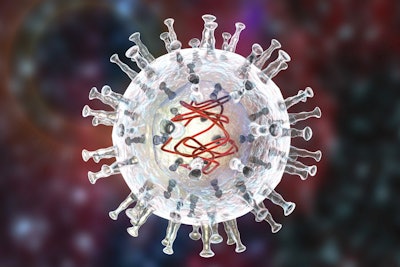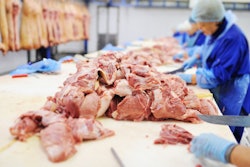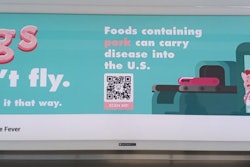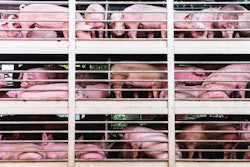
Professor and the teaching coordinator at the Department of Animal Sciences and Industry at Kansas State University, talks about the risks the feed industry could face if African swine fever were ever to make its way into the US.
What keeps Dr. Cassie Jones up at night? (20:21)
Ann Reus: Hello and welcome to the Feed Strategy podcast. I’m your host, Feed Strategy senior reporter Ann Reus.
In the past on this podcast, I’ve talked with experts about how U.S. pig producers can prepare for and prevent African swine fever, or ASF. Those aspects are obviously still very important, and you can find those conversations in our archives at FeedStrategy.com. Today I’m speaking with Cassie Jones, professor and the teaching coordinator at the Department of Animal Sciences and Industry at Kansas State University. We’re discussing the status of the disease in other regions of the world, where science is in the development of a vaccine for ASF, what kinds of risks the feed industry could face if ASF were ever to make its way into the U.S., and what feed facilities should be thinking about now to be better prepared for an outbreak.
Hi, Cassie. Thanks for being here today.
Cassie Jones: It’s my pleasure. I appreciate you having me.
Reus: We don’t have ASF in the mainland U.S., but it is present on the nearby island of Hispaniola, in the countries of Haiti and the Dominican Republic. How much of a threat does this pose to the U.S. and how are disease eradication efforts there going so far?
Jones: Yeah, thanks for the question. It’s, the current situation in Hispaniola is one that certainly causes me to lose some sleep at night. One of the more challenging aspects is that, while we understand that they obviously have a very different pork production system than what we do here and in the mainland North America, and mostly through the United States and Canada, that at the same time, there are some very concerning truths, like we don’t really know how African swine fever virus made its way into the country or into the island region to start with.
And the other very concerning piece to me is that, from the point of when it likely initially arrived until it was ultimately detected, we know that several months went by when everyone should have been at their highest alert for looking for potential clinical signs of disease. And at the same time, while we’re constantly supposed to be on guard for looking for the correct symptoms, and really watching out for this terrible disease, it managed to both enter Hispaniola and make its way into several different provinces and affect a number of different pigs before it was initially detected. And so both of those have me very deeply concerned about potential implications of what that means, even just from kind of a social sciences or from a human behavior world as we think about its potential transmission into the United States.
Certainly the fact that it’s geographically closer is a concern. And as we look at the location between Puerto Rico and the island, and that has us concerned. But really, it’s probably more the case of how did the virus initially enter and then how did it go and be spread throughout the island for so long without being detected? Those two questions are the pieces that probably have me most concerned. At the same time, though, this has now been in a relatively high alert state for several months. And so, during that timeframe, we still have successfully been able to prevent it from being brought into the mainland of North America. And so for me, I think that and consider that to be good news.
The second part of your question, though, was about the eradication efforts and how eradication efforts are largely going. And unfortunately, we’re not hearing good news from that side, as we hear from USDA and from our partners. It’s not great news, because it seems like, while on the Dominican Republic side, there perhaps is some movement in terms of containment and control in some aspects, as we move to the Haiti side, there are so many social issues that just really need to be ranked higher in terms of managing the current human health and current safety aspect of humans that are currently ranking higher than control of a foreign animal disease that only affects animals. And so because of that, we know that USDA has had significant challenges. Even the Haitian government has had significant challenges with controlling ASF within their borders. And because it is geographically connected to the Dominican Republic, that’s largely led to the entire Hispaniola region for moving from an eradication effort to much more of a control effort, where now we’re looking at a situation moving forward where it’s likely that, instead of looking to stamp out the disease altogether, that we’re really just looking to instead control and hopefully contain the disease of where it’s at.
Reus: Do you think prevention efforts in the U.S. are robust enough and how well do you think U.S. swine producers are prepared for a possible outbreak of ASF?
Jones: I’m very optimistic that our commercial swine industry and our integrated swine industry, in terms of kind of what 98% of pork production is within the United States is very well prepared. And would likely if a disease enters through that chain, regardless of how it entered, would likely have the technology, would likely have the training and the resources available to identify, contain and quickly eradicate the disease. So if it came in through what we would consider to be a conventional swine production route, I’m very confident in that area.
Where I’m not as confident would be the fact that we do have feral pigs. And we have the other aspect of whether you’re looking in Canada through the northern parts of the United States, certainly through the southern aspects of the United States through Texas and Oklahoma. If this were to come in through a feral pig population, or become a challenge within any of our feral pigs, I believe that eradication at that point would nearly be impossible. And so I worry at that point about how quickly would it take us to detect. How long would it take us to even have a plan for how to potentially eradicate? I very much credit all the folks who are working in that area because I think that we’re making quick progress. But at the same time, as we look at other countries and their ability to successfully eradicate or not eradicate the disease, it has been dependent upon their ability to control and prevent access into feral pigs. And so for me, that’s really the linchpin of how the disease potentially could enter, and if so, what type of pork production could it potentially affect.
Reus: What is the biggest risk for the feed industry when it comes to an ASF outbreak?
Jones: I think that there’s a lot of different potential risks that could exist. Usually, people initially go just to ingredients. I’m probably one that would disagree with those. Where I think that there maybe is some risk with imported ingredients from maybe countries or regions where ASF is present, I am much more concerned about the feed industry’s potential risk of transmission, if ASF enters, in terms of just the number of movements that we make through the feed industry. When I think of one area that I think the feed industry probably has the most opportunity to work on, it’s likely the delivery of feed itself. I think that we have a strong protocol and our producers are, and the feed industry collectively, has very strong protocols in place, and has been very proactive about understanding what are risks. What is the reality around those risks, and what can we do to manage the risks themselves?
But as we think of what role could the feed industry potentially play, I think it’s very unlikely that a feed or ingredient is the initial source of something like African swine fever virus or a different foreign animal disease to enter into the United States. However, I think it is possible for the feed industry to play a role in terms of potential transmission. As we’re looking at how that disease can move from one farm to another, as we’re going through the process of trying to detect and identify what is causing the clinical symptoms, and how are those being detected and what pigs are being impacted. And so during that fact-finding mission, I think it is a possibility that we could see continued movement of feed delivery trucks, and that, ultimately, it’s the delivery or the movement of feed, not necessarily the feed itself that potentially could cause some of our biggest challenges.
Reus: Tell me about work that’s going into a possible ASF vaccine and where some of those efforts are in the process. Are you hopeful that we’ll have a viable vaccine for ASF someday?
Jones: The vaccine efforts for me are pretty interesting. You know, I think that it’s one where it would be the silver bullet for a lot of variety of different reasons. But I also always try to caution people who are very vaccine driven, to just kind of really understand what it would mean if we needed to move to something like a vaccine. You know, for me, I look at really foot-and-mouth disease, and how we’ve seen other countries handle foot-and-mouth disease with their vaccine, and still consider themselves to be an FMD-positive country. Right? And so this is not maybe a solution to the end all be all, we would no longer have African swine fever virus. A vaccine would ultimately likely be the way that we could potentially control the disease if it were to break.
And so understanding that itself, I’ll maybe more directly answer your question of kind of where are we on some of these vaccine candidates and what do they look like. To maybe help frame that conversation a little bit I’ll start with there are really kind of three main types of vaccine candidates. One would be a live vaccine, it’s an attenuated vaccine, that would have a weakened virus, but it would still be a live virus. And so the role there would be that it would mimic some type of natural infection, but not enough to cause any substantial symptoms. That research by far has shown to have the best protection. However, there’s also some very real concerns with safety regarding the use of a live vaccine. And so we don’t know how many passages would it need to go through before it could potentially become virulent. And so as we think of the use of something like a live vaccine, it’s for me probably the one that’s most likely to be commercialized the soonest. And it’s probably the one that, if or when it’s commercialized, it would be the one that would be used in in emergency use in countries with large pig populations like the United States, but again, under an emergency use. It would not be a preventative vaccine, it would mostly be a, OK, we accept that we have African swine fever virus and the way that we can best manage this disease today is through the use of this live vaccine. But again, very similar to what we would see, with some countries in South America, for example, this would still lead us to a status where we would be positive for the disease, but it would be considered to be controlled through some type of live vaccine.
The other two types of vaccines, I think, for us are maybe a little more exciting that are further down the road. So one would be a non-live vaccine or a killed vaccine that would contain an inactivated virus. And so that would allow the body to recognize the antigen, but it’s at a lower risk level. And, unfortunately, that also comes with a lower immune response. So usually something like a killed vaccine would typically take multiple doses to both build that immunity but also maintain the immunity. And so while that’s one that we have successful killed vaccines or non-live vaccines and vaccination protocols that we use as a preventative for several different types of pathogens and viruses right now in the United States for pigs, that’s one that on the African swine fever virus front is much further down the road. Thus far, most of the research has failed to induce an effective immune response with a killed vaccine.
Then there’s kind of a middle ground. And so that would be a subunit vaccine. A subunit vaccine would contain a part or a subunit, thus the name, of the virus instead of the entire pathogen. Again, the downside with this type is that you would need multiple doses to build immunity and then to maintain that immunity. But there is some progress here, where I think that we’re making some progress scientifically on identifying what are the protective antigen subunits. But those vaccines have mixed protection. They’re certainly not going to be as viable, as effective as a live vaccine, but hopefully, their efficacy over time, and then as we continue to work in this area can increase and then likewise, we’ll be able to continue to make movement so that we can figure out a way to hopefully be able to provide those with fewer doses. Again, when we think of something like a feral pig population, where vaccinating one time is a big enough challenge, the multiple dose component is really one of our biggest stumbling blocks when we think of something like a subunit vaccine compared to a live vaccine. But the advantage of a subunit vaccine is that it would be much less likely to have the same safety concerns that we currently would have with many of the live vaccines that we see coming about in some of our international partners.
Reus: You have mentioned feral pigs a couple of times. How much of a threat do wild boar pose to the U.S. swine herd and what do you think should be done to prevent wild boar from spreading disease to domestic pigs?
Jones: I’ll initially answer your question regarding African swine fever virus and so, while I have friends and neighbors who have locations that are impacted by feral pigs right now in the United States, and I always sympathize with them because it is a massive headache within the United States, within even areas of Canada are having substantially more issues with feral animals and feral pigs specifically. And so I think, initially, those pigs themselves are causing substantial infrastructure issues and then they are causing disease challenges. When it comes to African swine fever virus, because the disease is not currently in the United States, it’s not currently in mainland North America, they pose no more threats to actual disease transmission than any other pig that is also free of African swine fever virus in North America.
That said, I think our concern would be, if we would have disease or ASF, were to enter through the route of either wild boar or feral pigs, that the potential containment and detection through those routes would be much more substantial. And we would really have some challenges to initially detect and just the speed of detection. But then likewise, the containment of disease in that type of situation. Because what of course, is the challenge with a wild boar or a feral pig situation is that then the pigs themselves can have the disease, but we also have the potential for soft-bodied ticks to also have issues and so in areas in California, through southern Texas, certainly into Mexico, where we would have the crossover of both wild boar or feral pigs that could potentially have African swine fever virus and the ticks that could also carry the disease and potentially transmit it to others. That’s where eradication would largely become almost impossible without the use of some type of vaccination effort.
Reus: I recently saw you give a talk where you spoke about having a “peacetime” and a “wartime” biosecurity plan. Can you explain what you mean by that?
Jones: Sure. Yeah. So recently, I spoke at a feed industry conference and encouraged producers, both on the swine producer side as well as within the feed industry to start thinking about biosecurity in terms of having a “peacetime,” meaning, this is kind of our typical as we stand today, approach to biosecurity, but also have what I was calling and call a “wartime” strategy. And so a set of protocols that you hope to never have to implement, but if you do you at least know what you would potentially do.
And so some examples of this would be something like feed delivery, like we talked about in our prior conversation. So, as we think about a typical feed mill today, we have what we would consider our routine biosecurity measures. And that would maybe be something like delivering in a biosecurity pyramid, start with some of your healthier and lower-risk populations moved to higher-risk populations, vice versa, as appropriate, allow trucks to sit overnight, and sanitize the exterior of those trucks as necessary, depending upon which animals you’re going to go service next or feed next.
When it comes to something like the switch is flipped and now we’re in an African swine fever virus potential environment, that very quickly changes some of those protocols. And what we don’t want at that time is for people to start thinking for the very first time about what would I do and how would I do this. So for example, if you’re a feed mill, and one of your customers or one of your clients is ASF positive, how could you continue to deliver feed to that facility, to that farm and still maintain the safety of others? I know that the knee-jerk reaction is, well, I just wouldn’t deliver feed to them. But the reality is that we may need to have some level of feed delivery at some point, even while we’re going through the process of euthanizing those animals, just for welfare reasons, we can’t allow them to starve, right? And so how would we get feed to them? That may be some very unconventional things. A feed mill that typically does not deliver bagged feed, or that typically would never send things in an old grain truck, we may have physical barriers from one location to another and in in the case of what we’ve seen, in some countries like Vietnam, we may have a feed truck that we consider to be a “dirty” feed truck, and we may auger feed over that clean and dirty line. Or we may send feed from one location to another and just be much more creative in how we could potentially get animals fed if and when necessary.
Likewise, if we know that African swine fever virus is present in a neighboring county, what would your facility do? Or if you knew that you delivered to an ASF-positive facility, what would you do to that truck or to that vehicle before returned back to your facility? That’s what I mean in terms of these wartime activities. Things that in a normal context of our current endemic diseases seem to be pretty extreme. But I don’t want feed mills or producers to be thinking of them for the very first time once they’re hit with that situation. These wartime biosecurity procedures are things that hopefully we think through, we talk through and in the best of all situations, we never actually have to implement but they’re there if we need them. And so that’s what I mean by that peacetime versus wartime biosecurity.
Reus: Well, thank you so much, Cassie. You’re always such a treasure trove of great information.
Jones: I appreciate the opportunity. Take care.
Reus: And thank you to the audience for listening. I’m Ann Reus for Feed Strategy.

















